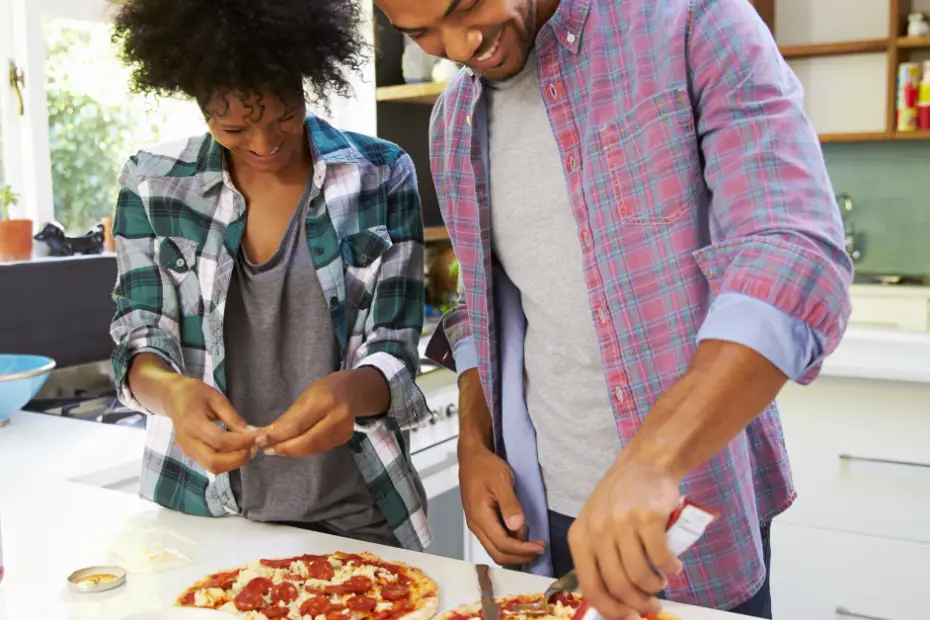It’s no secret that I’m a big eater. In previous articles, I’ve described myself as a social eater, and sometimes that makes me do crazy things. This time I may have gotten myself in a bit over my head. I figured, “What’s the big deal? I cook pizzas for groups all the time. How hard could it be to cook for 150+ people?”
DISCLOSURE: This post may contain affiliate links, meaning when you click the links and make a purchase, we receive a commission at no extra cost to you.
I love to make pizza for people. We have friends over all the time. Groups of 20 to 30 really aren’t a big deal to me, so this summer I talked my brother into signing up to cater a pizza party at our family reunion for more than 150 people. I’m still not sure that he has forgiven me for that!
You see, I’m an Arizona native but have been living in the Atlanta area for the past 11 years. Because of that, I don’t get to see family much – which is why I try to bring my family out west…to Arizona…in the summer…because that’s the smart thing to do.
Whenever I do get to Arizona, I try to pack in as much fun and family time as I can. That’s why I get excited when it is the year for my mom’s family to have a giant family reunion.
It’s usually a 5-day fun fest full of all kinds of activities during the day, like whiffle ball/kickball, fishing, swimming, hiking, crafts for the kids, stories, and catching up with the extended family that I grew up with. And I just love that all our kids get to play together with cousins – the way I got to grow up with mine.
Then at night we (the troublemakers) stay up until 2AM playing card games and enjoying time with just the adults while the kids are sleeping.
And this year the reunion was at the AMAZING Legacy Lodge in Heber Arizona. If you haven’t heard of this place, check out this 4-minute video – it will blow your mind!
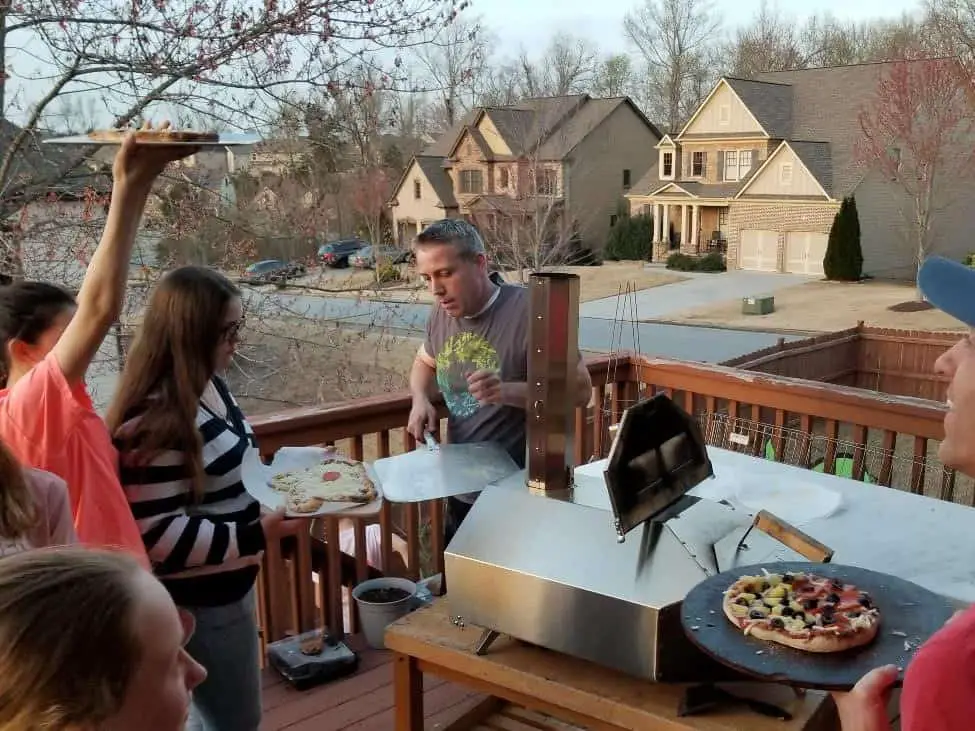
Anticipating all this fun, I understandably got caught up in the excitement and wanted to do something big – like bring up 5 pizza ovens and make 170 pizzas for the entire group! Doesn’t that sound fun?!
I tell you it was fun (don’t listen to my brother)! It was hard work – but fun! I loved to see all the smiling faces! Everyone was so excited and appreciative that we would go through so much effort to do something special for them. It made me happy, and I’m so glad we did it!
I am not experienced in planning food for this many people, so it was a challenge. There were a lot of things that I would have changed if I could go back and do it again (which I’m sure I will).
I learned some very important lessons through the mistakes that I made. In this article, I will explain how I would approach it today – and spare you most of the pain I had to go through to learn these lessons.
If you doubt you will ever throw a party of this size – don’t worry. You could still learn a lot by reading through my planning to help you with your much more modest pizza parties. My 20-30 people pizza parties are so much easier now that I follow these simple processes. Obviously remove or add processes that fit the needs of your party.
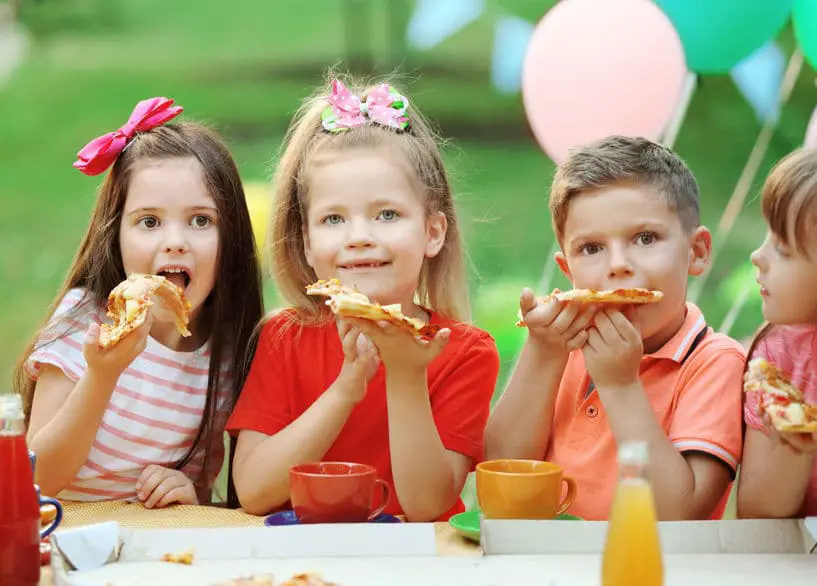
PLANNING
At first I thought it would be easy. What could go wrong…besides running out of food, taking too long to prepare the food, or a hundred other fears that started creeping into my mind as I started writing down what needed to be done to get ready.
I tried to separate of the planning into multiple areas:
- Food
- People
- Workplace Setup
FOOD PLANNING
My favorite part! What do you think I did to help me figure out how much food to make? That’s right, I threw a pizza party!!
A week before the reunion I threw a pizza party for my awesome cousins from my dad’s side of the family! We like to get together for games anyways, so this was a natural fit.
- Goal 1: Have a great time and make it an experience that they and their kids will remember!
- Goal 2: Count the number of pizzas consumed at the cousin party and multiply by a factor that would tell me how many pizzas we need to make at the family reunion.
- Goal 3: Test store bought dough to make sure it would cook well in our pizza ovens.
Goal 1
Have fun! It’s easy to get caught up in the work that you forget to have fun. Even if things go wrong or people want to do something their own way, remember one thing – the people are more important than the pizza. Don’t let anything get you down, and focus on making good memories!
Goal 2 – Pizza math
There were about 30 people at the cousin party and we expected at least 150 at the family reunion. That’s easy! Multiply the number of pizzas consumed at the cousin party x5 and I know how many pizzas to make at the reunion.
I wish it was that simple.
First of all, we ran out of pizza at the cousin party – worst nightmare accomplished! You would think that 25 pizzas (about 10 inches in size) would have fed 30 people, but we underestimated the effect that our delicious pizzas would have on my cousins and their children. It’s like I come from a whole family of big eaters! I was so proud!
So, let’s say 25 pizzas would have been enough for 30 people, then that would mean that 125 pizzas would have been enough for 150 people. But what if we had more than 150 people? All we had was an approximate headcount. I might have gone a little overboard, but I did my math to plan for 170 pizzas – one for everyone that may, or may not be there! Turns out that we had 166 people at the reunion, so my guess was not far from the actual.
Goal 3 – Pizza Dough Test
I usually make my own dough. In my opinion, homemade dough is better than store bought dough! But, to cut down on the amount of time I had to spend on this project, we bought Trader Joe’s pizza dough.
We also had one gluten-free person at the cousin party and would have a handful of them at the reunion, so we also wanted to test the Wholly Wholesome Gluten Free Pizza Crusts at Sprouts. It passed the cousin party test, and was well received (at least I heard no complaints) at the family reunion.
I like to do certain things the scientific way, and dough size is one of them. At the time, I liked to make smaller pizzas with a dough ball that weighed 165 grams (now I prefer 190 grams of dough per pizza). The Trader Joe’s dough comes in a bag with 464 grams of dough. At 165 grams for each pizza, 9 packages equal 25 pizzas that stretch into about 10 inches comfortably. And at $1.19 per bag, that is only 42 cents per pizza.
TIP: For a 12”-13” pizza, I now like to use 190-gram dough balls. That means that a Trader Joe pizza dough ball would make 2.44 pizzas – or you can round up to 2.5 to make it easier.
Trader Joe’s dough is good. Not as good as homemade dough, but definitely good enough for our family reunion, or any time that you just don’t feel like making dough. Very much worth buying instead of making that much dough.
PLANNING FOR TOPPINGS
It was hard to determine from the cousin party how many of each topping to buy because at the party everyone made their own pizzas, while at the reunion we were going to make the same 10 pizzas over and over again.
In fact, when people make their own pizzas, they add way more cheese than if they are making pizzas for a crowd. Because of this, I ended up buying too much cheese for the pizza party at my family reunion. I guess too much is better than too little.
TIP: A “make your own pizza” party requires more cheese than a pizza party where the host makes all the pizzas. Count on 15-25% more cheese if they make their own pizzas.
The second issue with using this party to determine how many toppings to buy, was that there is no coordination as to what pizzas are being made. So, when everyone makes their own pizzas, they all look very similar.
For example, for the sauce they could choose from pizza sauce, Buffalo sauce, olive oil, pesto sauce, barbecue sauce, honey, or siracha. Almost every one of them used the traditional pizza sauce. To counter this, I have my older kids trained to make specialty pizzas only. Their favorites are Buffalo Chicken, Honey Siracha, and ‘The Kenna’ – a olive oil and minced garlic based pizza that my oldest daughter made up one day when we wanted pizza but somehow ran out of tomato pizza sauce.
I also bought way too much pepperoni for the family reunion because almost every pizza had pepperoni and one or two other toppings. Pepperoni and sausage, pepperoni and mushrooms, pepperoni and olives, etc. One cousin was brave enough to go out on his own and make a pizza with pesto sauce as the base.
TIP: Count on 50% more pepperoni for a “make your own pizza” party. If teenager girls are the dominant species, you cannot have enough pineapple.
Here are my rule of thumb measurements for pizzas with tomato based sauce and for pizzas with pepperoni. These are for catered parties, where we make the pizzas for the group. Remember, 25% more cheese and 50% more pepperoni for make your own pizza parties.
Rule of Thumb:
- Tomato Pizza sauce: 16 ounce bottle for 8 pizzas
- Cheese: 2.5 pound bag for 18 pizzas
- Pepperoni: 15 12” pizzas (MATH: 20 slices for a 12 in pizza. A 21 ounce bag of Hormel pepperoni has about 300 slices.)
TIP: Most tomato pizza sauces you get at the store are thin and runny. I prefer a thicker sauce because thinner sauces bleed through the dough faster and are more likely to make your pizza stick to the peel. And I think a thicker sauce tastes better.
PEOPLE PLANNING
These are the questions I had to ask myself to figure out how many people I needed to make pizzas for 166 people:
- What are the roles of each person?
- How many pizza ovens will I have?
- How fast do we need to get the cooking done?
- How much prep time before the first pizza cooks?
- Can we be stretching dough, adding toppings, and cooking pizzas all at the same time?
- How much counter/table space to I have, and where is it?
- How do I communicate with everyone what their role is and how to do it?
That’s a lot to process! I will hit all of these questions as I explain how I approached the planning process.
First, I created 3 main roles and 2 individual roles:
- Dough Prepper
- Pizza Topper
- Pizza Oven Chef
- Serving Table Manager
- Overseer (me)
ROLE 1: PIZZA DOUGH PREPPER
No matter how many people you have, they can all be dough preppers at the beginning. The goal is to get enough dough prepped so you have a good head start and the remaining dough preppers can keep up so you don’t end up having to stop cooking pizzas to make more dough.
Assuming you are limited on prep time and counter-space, if you are making 50 or more pizzas you should definitely not wait until you have all of the dough stretched before moving on to topping and cooking the pizzas.
ROLE 2: PIZZA TOPPER
If you are catering for a large group, and not offering a ‘make your own pizza’ option, I recommend you setup a limited menu of pizza options. For the family reunion, I chose 10 pizzas that I my pizza toppers would make. Some were very traditional and kid friendly, while others were more adventurous and fun.
I selected 8 Pizza Toppers and assigned each of them a pizza to be in charge of. Their job was just to make that pizza and nothing else unless the Serving Table Manager told them to help catch up on a different pizza.
You may have noticed that I chose 10 pizzas and only had 8 Pizza Toppers. I chose the 4 pizzas that I thought would have less demand and doubled up the assignment for two of the Toppers. This is what it looked like:
The role of a pizza topper is fun and relatively easy because most everyone has put toppings on a pizza before. The key is to tell them exactly what pizzas to make, how to make them, and in what order. Planning this out up front will save you from having to stand over them and constantly remind them of what to do and how to do it.
Later, I’ll share more tips and tools for doing this easily.
ROLE 3: PIZZA OVEN CHEF
You need one Pizza Oven Chef for each pizza oven you are using. Unless you have seasoned pizza oven chefs, this is the hardest role to prepare someone for. In my case, two of the 5 pizza chefs had limited experience making pizzas in a pizza oven. The other 3 had never even seen a portable pizza oven before I showed it to them.
This is where you will likely run into your first roadblocks, so taking your time up front will minimize frustration and save you ‘fix’ time down the road.
This is what I recommend:
- Walk them through the simulated process. If possible, walk your entire team through the process even before beginning the pizza dough stretching. Let them get their questions out well before it’s time to cook.
If you don’t have much time before the first pizza goes in, still take the time to talk them through and let them visualize without a pizza on the peel.
- Start Slow. When the first pizza is ready, have everyone watch while your most experience pizza chef cooks the first pizza. Explain every step and let them see what success looks like. Encourage questions.
- Supervise everyone through their first success. After chef 1 successfully cooks a pizza, let him go to work while everyone else watches chef 2.
After chef 2 is successful, chef 1 and 2 will work on their own while everyone remaining watches chef 3. Keep doing this until all chefs have had the opportunity to be successful with your direct supervision.
It takes less than 2 minutes to cook each pizza, even with instruction time, so this doesn’t take long, but it will pay off by minimizing the chance of the chefs getting frustrated by learning on their own by making mistakes.
There will still definitely be issues and probably ruined pizzas along the way, but you just got them over the much of the learning curve and less support will be needed along the way.
ROLE 4: SERVING TABLE MANAGER
You probably only need one Serving Table Manager. I recommend selecting someone the is organized and not afraid to make a decision and give orders.
This person will cutting up the pizza when it comes out and telling the Pizza Toppers if there is too many of one pizza and too little of another pizza.
That may not seem like much, but in the heat of the battle it is super helpful for someone that can keep track of all of that and isn’t afraid to give the order.
ROLE 5: OVERSEER
Probably only need one Overseer. This was me. There is so much going on, that you don’t know where the problem is going to be.
I knew I couldn’t make myself a Pizza Chef, because if I needed to help another Pizza Chef we would have two ovens out of commission.
If I was a Pizza Topper, then we’d fall behind if anyone else needed help.
As an Overseer, not only could I help when asked, but I could proactively look for ways that individuals and the overall process could improve.
WORKPLACE SETUP PLANNING
SETTING UP THE TABLES
This already complex family reunion pizza party was made even tougher by the fact that I had never seen the space that we would be working in.
As it turned out, there was a giant table inside (with hand carved thrones at each end – so crazy!) with more than enough 6 foot folding tables. I prefer a 5 foot round table for topping the pizzas so the ingredients can be in the middle more easily reached by everyone, but I did not have that as an option.
I never trust a plastic table to get clean enough to prepare food directly on it, so I like to cover each table with 24-inch-wide butcher paper.
I used to use parchment paper, but it is non-stick so it doesn’t tape down well and is easily affected by the wind. So, if you’re preparing and serving food outside, I recommend that you tape down parchment paper on all your tables to provide a surface that you can feel comfortable enough to eat off.
Of course the tables holding the pizza ovens need no parchment paper. I like to put a red and white checkered tablecloth on the serving table before the parchment paper – for style.
PIZZA TOPPING BOARDS
With a project this size, you will likely have helpers that have never made their assigned pizza(s). This is made even worse when at some time in the project all of them will likely have to make a pizza that is not their assigned pizza.
My solution was to create pizza topping boards like the one below.
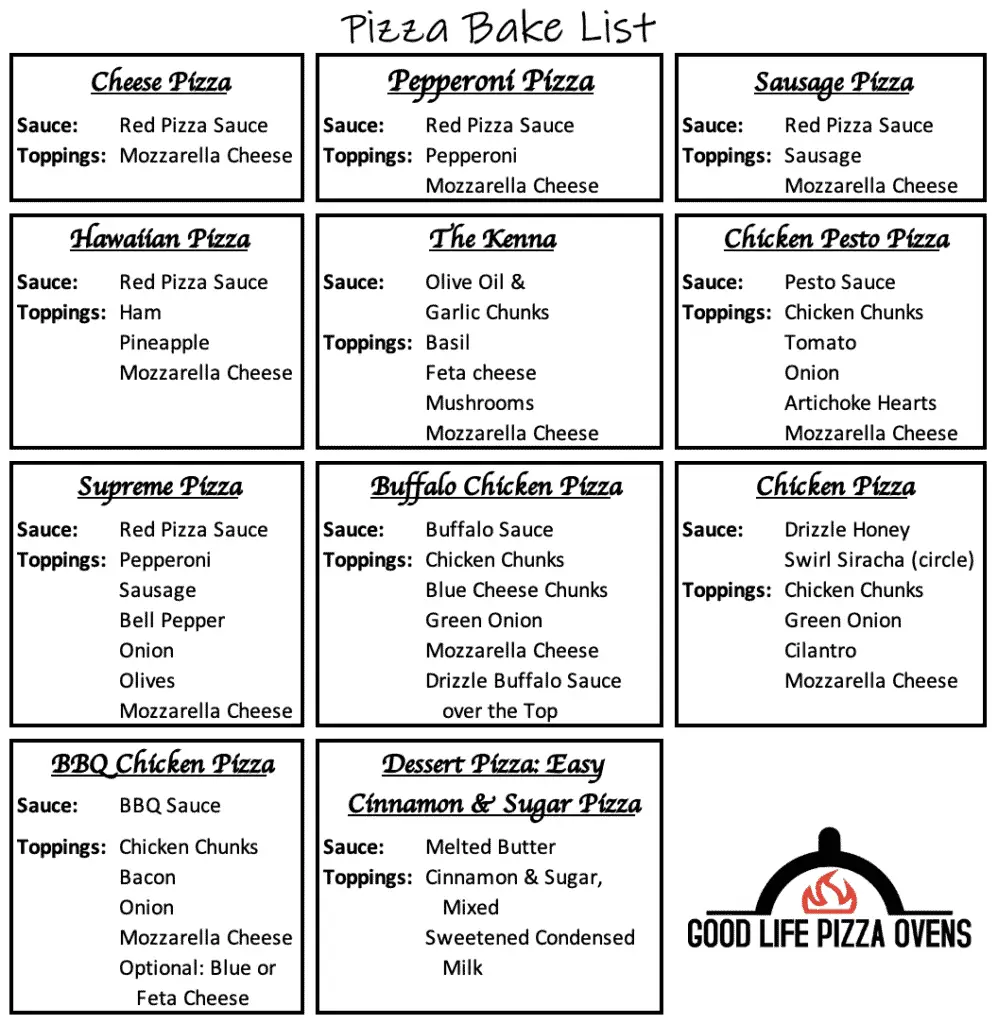
These boards had quick assembly instructions for each pizza so that anyone could just look at the board and know how to make the pizza.
The beauty of these topping boards is their simplicity. They do not say how much of each topping in ounces or cups – you likely won’t have time for careful measurement.
The topping boards do suggest the order in which the ingredients should be added, but usually if not done in that order the pizza will still turn out fine.
I created a document with our favorite specialty pizzas that can help you make these topping boards. They are the right text size to be easy to see and fit 10 on a single poster board. I use a foam poster board so that it is sturdy and can be self-standing.
If you want instructions on how to make the pizzas from my “Pizza Bake List” above, check out my article 13 Topping Combo Ideas for a Pizza Party (Free Printable) and find out which of our pizzas is a party favorite.
PIZZA OVENS
We used 5 different pizza ovens. This may have been more than we needed, but I wanted to be able to get pizzas out as quickly as possible.
We had a wood-fired pizza oven on a mobile cart and 4 propane gas pizza ovens on two tables. We had two propane bottles with a y-splitter so we could run two ovens off each propane bottle. There was plenty of power and we still had lots of fuel left in each tank after the pizza party was over.
From left: Authentic Pizza Ovens Maximus Arena, Ooni Pro, Ooni Koda, Ooni 3, and Napoli
PIZZA SIGNS
People like to know what they are eating. They are more likely to be adventurous and try something new if they at least know the name of the pizza – or even better what is on it.
Since many of the pizzas I selected are likely unknown to my extended family, I thought it would be better to provide both a name and list of ingredients.
On the serving table, I made a table name card for each pizza and taped it to the table. This told the Serving Table Manager where to put each pizza and told the diners what they were eating.
I also created a duplicate pizza topping board, exactly like the one used by the pizza toppers, and hung it up where everyone could read while at the table so they could more easily decide on which pizzas to try.
PIZZA ASSEMBLY LINE
The pizza making process is an assembly line so this is how I recommend the pizza making process should flow:
Dough Stretching Tables (or one giant table with thrones at the ends):
- Roll out the dough to about 8 inches.
- Hand stretch the dough to roughly 10 inches and lay them out on the butcher paper
- When a Pizza Topper is ready to start a pizza, they should:
- take a peel (I prefer wooden peels for launching pizzas)
- lightly sprinkle on some corn starch
- hand stretch again to about 12 inches (easier now after the dough had time to rise while stretched flat)
- lay it on the peel where the side that was up on the table is now facing down
Pizza Topping Tables:
- All ingredients should have been set out ahead of time.
- Pizza Toppers put the toppings on the pizza (had to say it).
- I recommend that when they think they are done, they take a quick look at the pizza topping board and make sure they included all ingredients.
Pizza Oven Tables:
- The Pizza Topper should carry their pizza over to the pizza oven table and give their peel to the Pizza Chef to launch the pizza into the oven.
- If all pizza ovens are occupied, they need to wait in line for an oven to open up.
- The Pizza Topper should tell the Pizza Chef the name of the pizza.
- Once the pizza is in the oven, the Pizza Topper should go back to make another pizza.
- Once the pizza is cooked, the Pizza Chef will carry it over to the serving table, tell the Serving Table Manager the name of the pizza and put it on the table in front of the correct name card.
Pizza Serving Table:
- The Serving Table Manager cuts the pizza (I prefer rocker pizza cutters).
- I recommend cutting the pizzas into 8 slices. Cutting them into 4 or 6 slices makes it hard for adults to try multiple pizzas.
- 8 slices also minimizes waste from kids that grab more than they can eat.
- If there are too few, or too many, of any given pizza the Serving Table Manager will tell the Pizza Toppers.
- Pizza toppers will call out if they are making the requested pizzas so you don’t have everyone switch over to the requested pizza.
PIZZA OVEN DISCUSSION
Congratulations! If you made it this far, you are ready to throw an incredible pizza party of any size!
If you don’t have a pizza oven yet, you are probably wondering which one you should get.
If you already have a built-in pizza oven as part of your outdoor pizza kitchen, you might be wondering which portable pizza oven you should get to take the party on the road – or to bring out when you have a large enough group to justify a 2nd oven.
The first question to ask is ‘wood or propane’?
The reason I start here is that there are ‘wood purists’. If you are a wood purist, you wouldn’t be caught dead cooking with propane – and I understand your argument.
When I interviewed Chef Brad to help him select a pizza oven, there was no doubt that it was going to be a wood fired pizza oven. The only compromise would have been to get a hybrid oven that used propane for consistent heat and wood for the smoke and extra flavor.
If you are more worried about ease, convenience, and making lots and lots of pizzas in a short amount of time – then you’re likely a propane guy like me.
WOOD PIZZA OVENS
If you are a wood purist looking for a portable oven, in my opinion there is only one oven for you – the Authentic Pizza Ovens Maximus. This oven is available as a 130 pound Arena or a 300 pound Prime. If the Prime is portable enough for you, it will be worth the extra weight for the ability to cook multiple pizzas at a time.
Why the Authentic Pizza Oven Maximus?
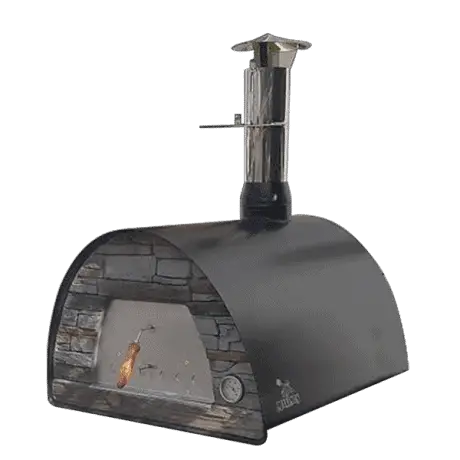
Two words – heat retention.
I love the smaller multi-fueled pizza ovens like the Ooni Pro and Napoli Pizza ovens. These ovens can also use wood and charcoal to cook, however they don’t retain heat very well. This means that you are having to add wood way too frequently for a pizza party. They are great if you are doing a handful of pizzas, but if you are doing more pizzas than that, you need incredible skill and extra time to keep the oven temperature at the right level without leaving your pizzas tasting like ash.
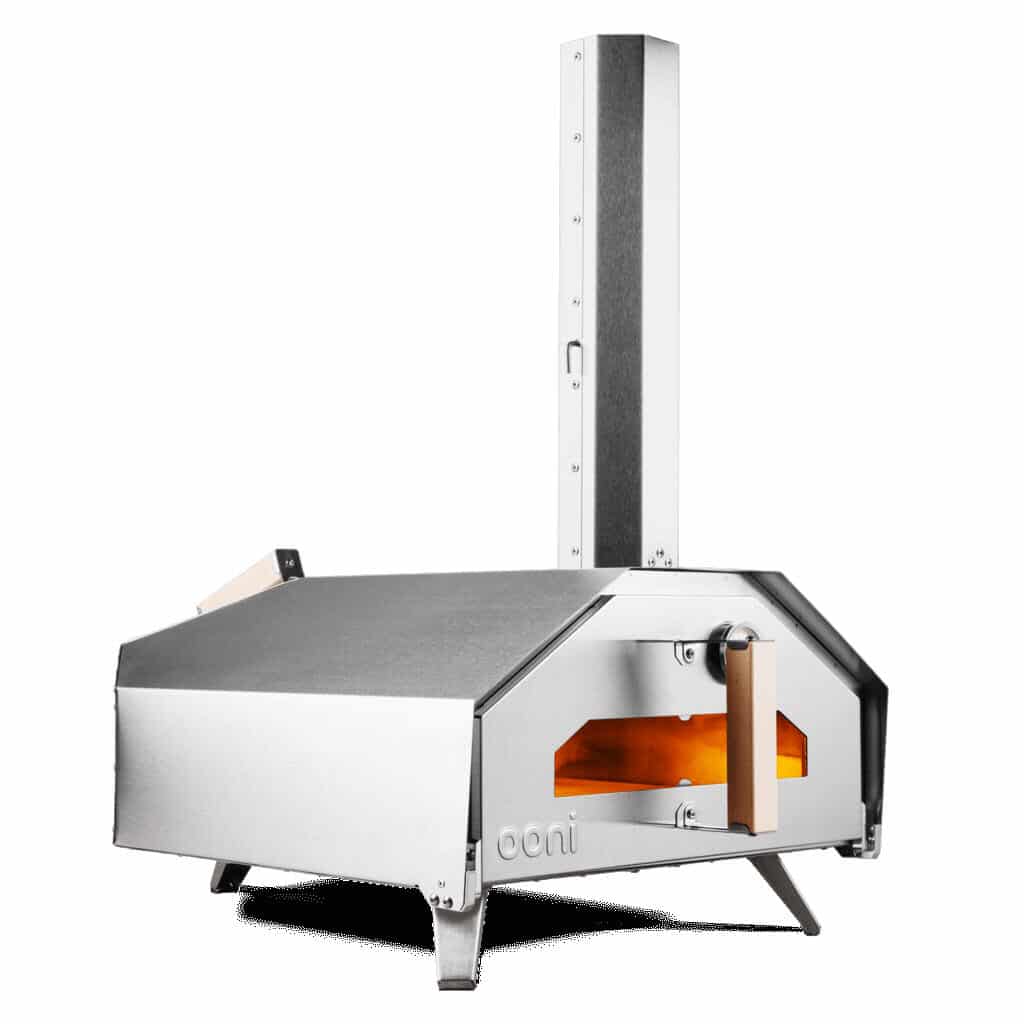
With the Maximus, you start by building the fire on the stone in the area where the pizzas will be cooked – making the stone hotter than you can usually get with the other portable wood ovens.
When you’re ready to cook, you simply brush the coals to the side and they continue to heat the oven.
You can fit much more wood in the Maximus than either the Ooni Pro or Napoli ovens, plus the Maximus has much better insulation to keep the oven hotter for longer.
The Maximus insulation is even good enough where Chef Brad likes to put in a roast after he’s done with pizza and close the door to let it cook for hours – taking advantage of the residual heat.
PROPANE OVENS
I once wrote an article about why I thought Wired Magazine was wrong in picking the Ooni Pro as their top oven and the Ooni Koda as the first runner up. I had used both and am a much bigger fan of the time and effort saving propane-burning Koda over the wood-fired Pro.
Then I got the Ooni Pro Gas Burner!
Life changing!
If I only need one oven – my choice is the Ooni Pro with the gas burner almost every time.
Because it is bigger, it is just so comfortable to fit a 12-14 inch pizza and give you room to maneuver.
It also allows you to use the special pizza door so you don’t have to keep opening and closing the door every 15-20 seconds when you turn it.
I also love desserts – another great pastime for a social eater. The Ooni Pro’s size makes it easy to throw in a cast iron skillet for apple crisp, peach cobbler, or whatever your heart desires!
And with the gas burner, you can quickly turn down the heat to cook whatever your heart desires.
It is just so easy! And with the cover on I can store it outside. I just keep it on a mobile cart so when I’m done cooking I can roll it under my deck’s awning.
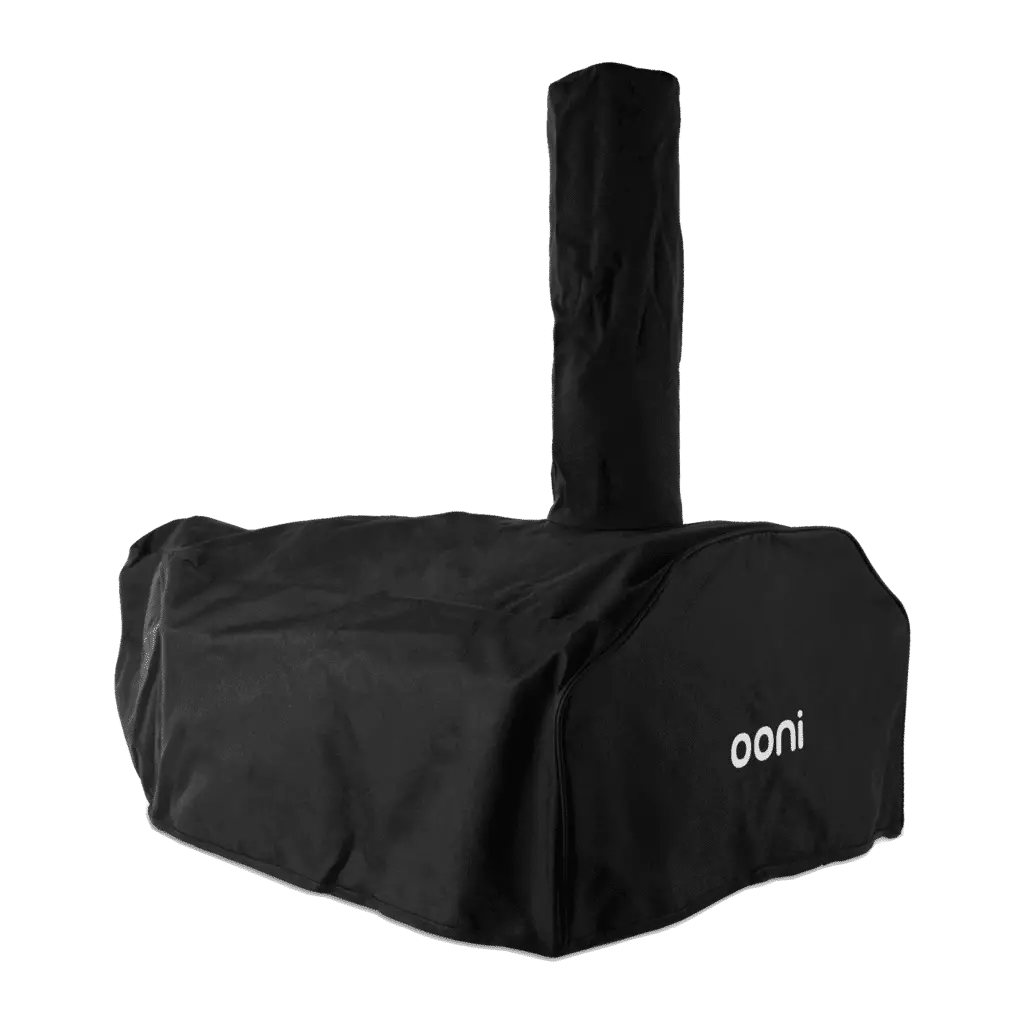
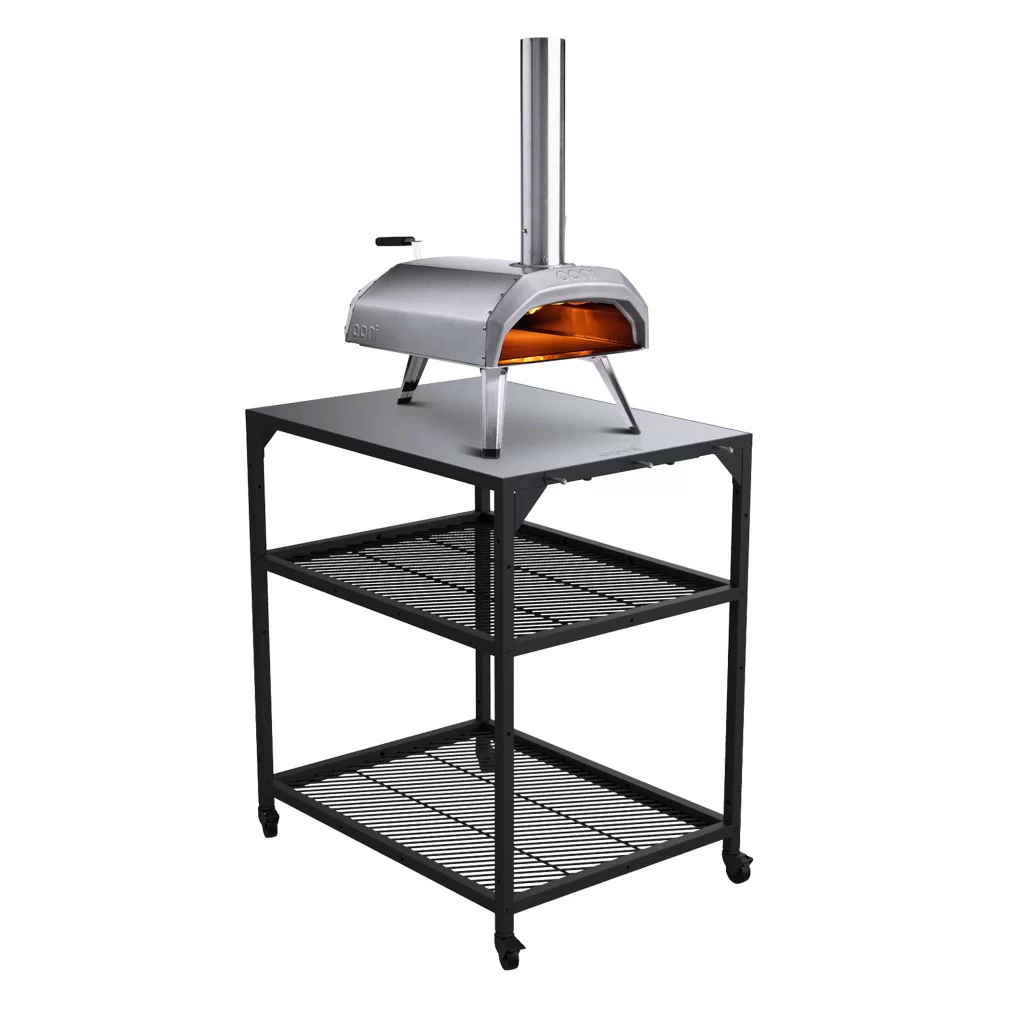
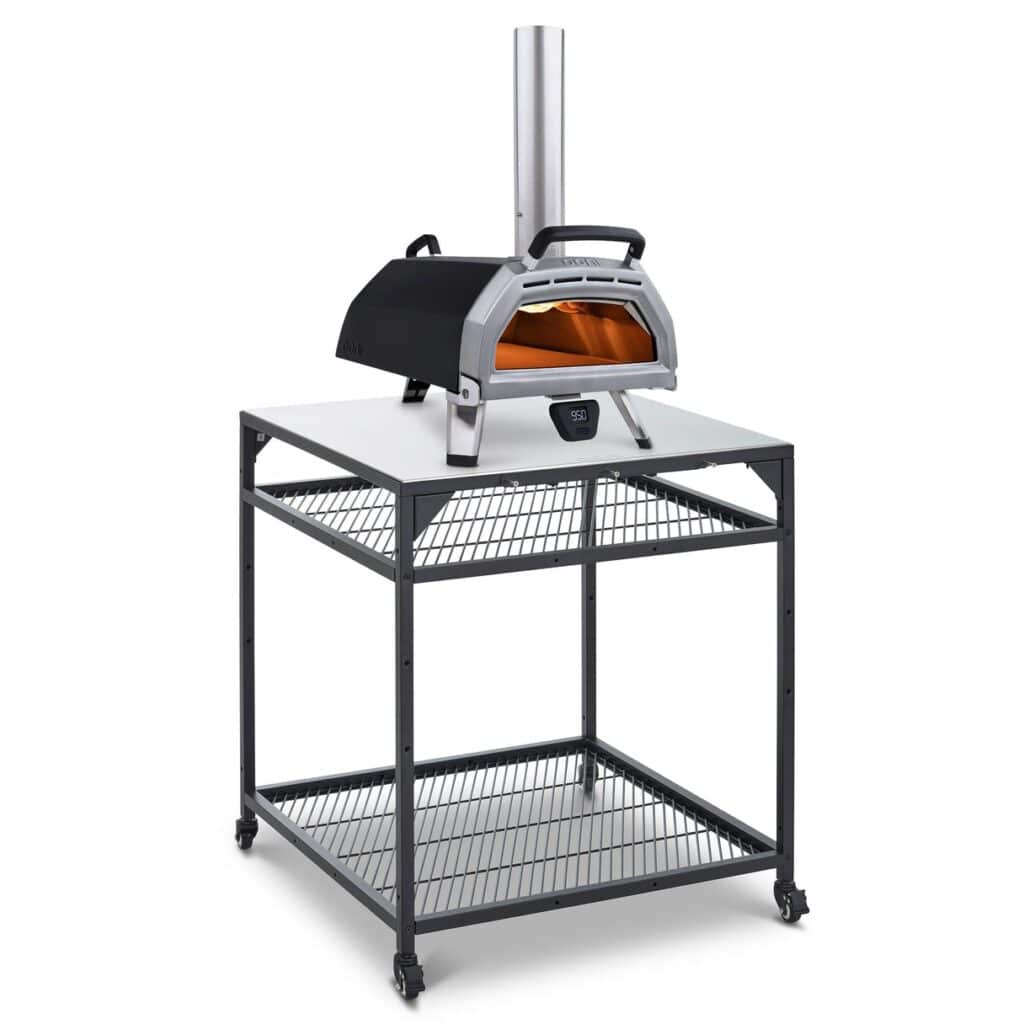
The biggest advantage of other propane portable ovens, like the Ooni Koda, Napoli (with optional propane burner), and Ooni 3 (with optional propane burner) is their portability.
A friend of mine has 5 daughters (wow!) and I found out one day that the two youngest were sick.
I made him an offer. I told him that my daughters and I would like to make him pizza. We could either 1. make it and bring it over, or 2. I could bring the oven and ingredients over and we could have an impromptu make your own pizza party at his house for his healthy girls.
They chose option 2.
My daughters and I quickly whipped up a batch of pizza dough (this recipe is so good and quick!), loaded up a cooler bag with sauces and toppings, and grabbed the handles of my Ooni Koda carry case – and we were out the door in record time.
I could have thrown this last minute pizza party on the road just as well with the Napoli or Ooni 3, but Ooni Koda with the optional carry case is just so amazingly portable!
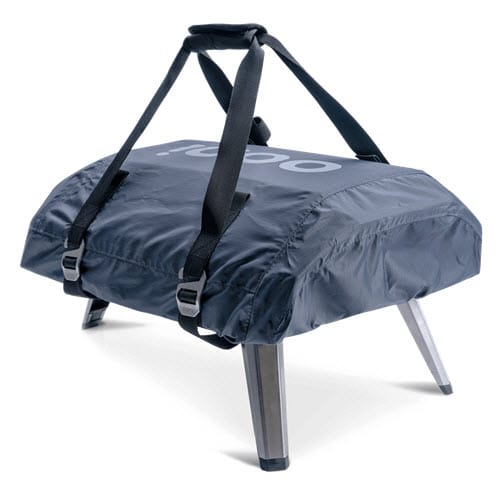
Multi-Fueled Pizza Ovens
If you can’t decide whether you want a wood-fired pizza oven or a propane gas pizza oven, then you might want to consider one that can use either as a fuel.
The Ooni Pro is bigger and is often used to cook steak or vegetables on flat, cast iron skillets or may dishes and desserts in cast iron or ceramic pans.
The Napoli has just as many options for wood or propane fuel, but is smaller and really just intended for pizza. It is also half the price, so if you just want it for pizza, this may be your better option.
AFTER PARTY!
I told you that my biggest fear was that we would run out of food. So, after the family reunion pizza party ended I took inventory and realized that I had quite a few extra dough balls as well as extra cheese, sauce, and toppings.
What did I do with the extra? You guessed it! When we got home from the family reunion, I threw a pizza party for wife’s family!
It was just another 30+ person party – no big deal after what I had just been through!
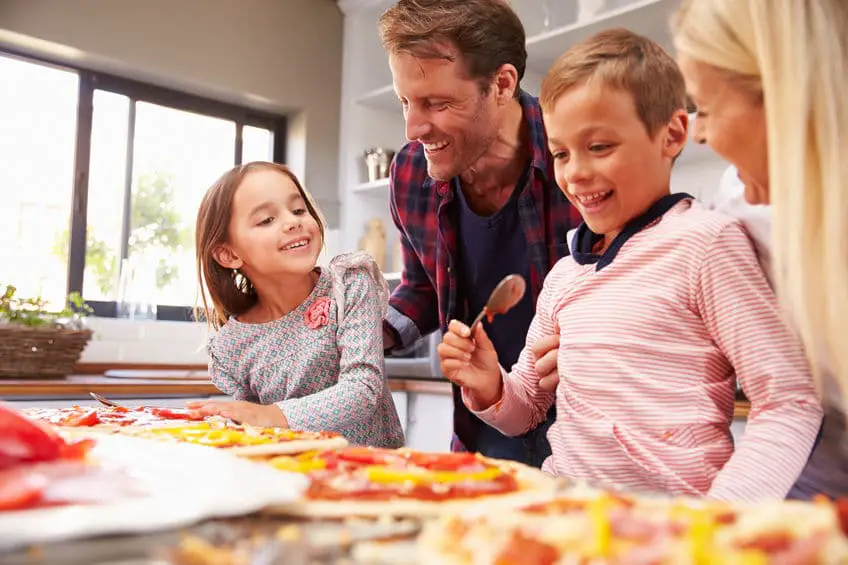
Check out some of our other articles below for other tips and tools to make your pizza making experience a success:

Tim is a self proclaimed social eater – so it’s not surprise that he’s obsessed making pizzas with his kids, friends, his kids friends, close family, extended family, people with the same last name but aren’t actually family, neighbors, random people in the neighborhood, and complete strangers!
There’s nothing quite like helping other people embrace their creative side as they make their own pizza masterpieces!
